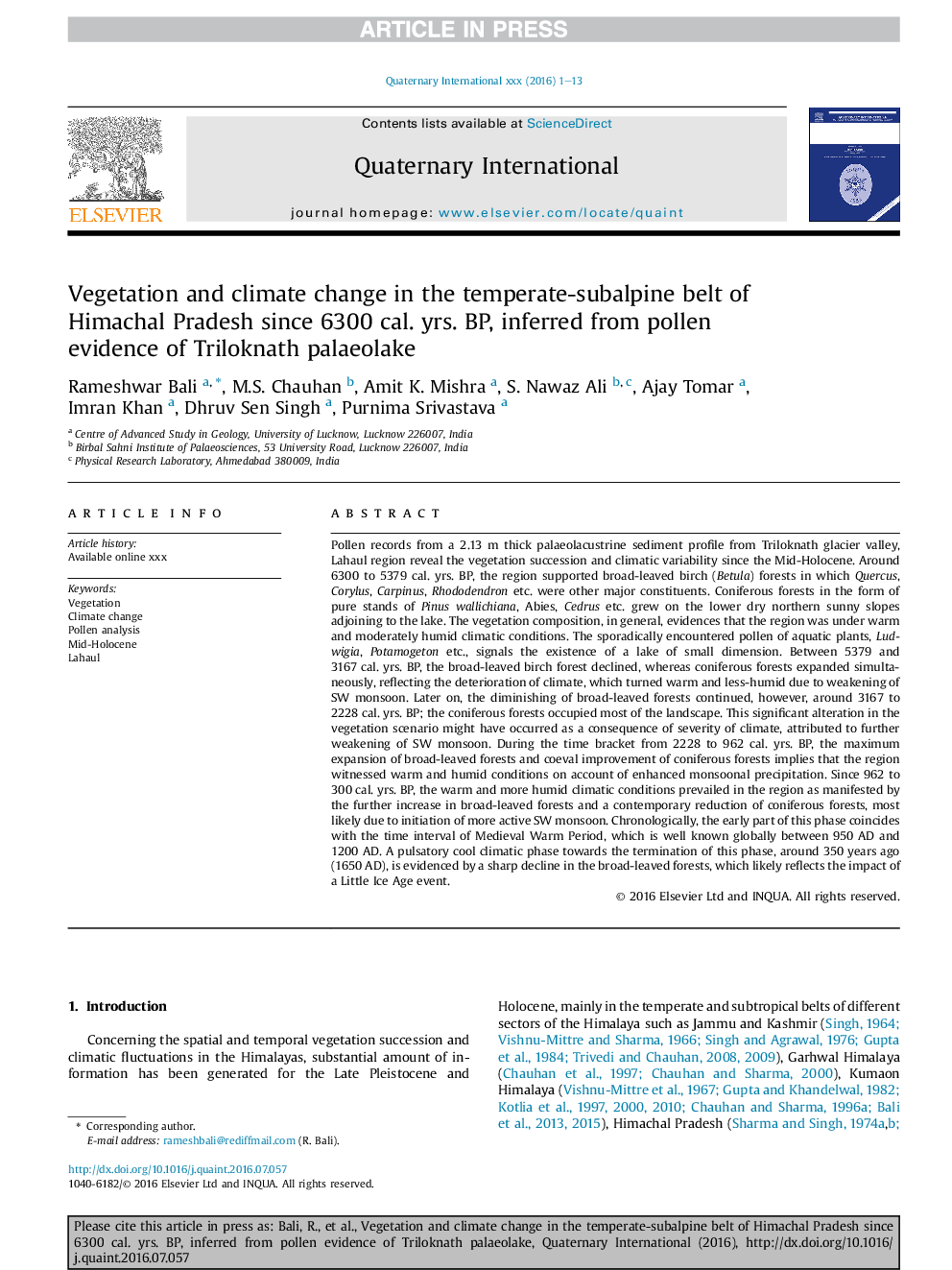| کد مقاله | کد نشریه | سال انتشار | مقاله انگلیسی | نسخه تمام متن |
|---|---|---|---|---|
| 5113381 | 1377929 | 2017 | 13 صفحه PDF | دانلود رایگان |
عنوان انگلیسی مقاله ISI
Vegetation and climate change in the temperate-subalpine belt of Himachal Pradesh since 6300 cal. yrs. BP, inferred from pollen evidence of Triloknath palaeolake
دانلود مقاله + سفارش ترجمه
دانلود مقاله ISI انگلیسی
رایگان برای ایرانیان
کلمات کلیدی
موضوعات مرتبط
مهندسی و علوم پایه
علوم زمین و سیارات
زمین شناسی
پیش نمایش صفحه اول مقاله

چکیده انگلیسی
Pollen records from a 2.13 m thick palaeolacustrine sediment profile from Triloknath glacier valley, Lahaul region reveal the vegetation succession and climatic variability since the Mid-Holocene. Around 6300 to 5379 cal. yrs. BP, the region supported broad-leaved birch (Betula) forests in which Quercus, Corylus, Carpinus, Rhododendron etc. were other major constituents. Coniferous forests in the form of pure stands of Pinus wallichiana, Abies, Cedrus etc. grew on the lower dry northern sunny slopes adjoining to the lake. The vegetation composition, in general, evidences that the region was under warm and moderately humid climatic conditions. The sporadically encountered pollen of aquatic plants, Ludwigia, Potamogeton etc., signals the existence of a lake of small dimension. Between 5379 and 3167 cal. yrs. BP, the broad-leaved birch forest declined, whereas coniferous forests expanded simultaneously, reflecting the deterioration of climate, which turned warm and less-humid due to weakening of SW monsoon. Later on, the diminishing of broad-leaved forests continued, however, around 3167 to 2228 cal. yrs. BP; the coniferous forests occupied most of the landscape. This significant alteration in the vegetation scenario might have occurred as a consequence of severity of climate, attributed to further weakening of SW monsoon. During the time bracket from 2228 to 962 cal. yrs. BP, the maximum expansion of broad-leaved forests and coeval improvement of coniferous forests implies that the region witnessed warm and humid conditions on account of enhanced monsoonal precipitation. Since 962 to 300 cal. yrs. BP, the warm and more humid climatic conditions prevailed in the region as manifested by the further increase in broad-leaved forests and a contemporary reduction of coniferous forests, most likely due to initiation of more active SW monsoon. Chronologically, the early part of this phase coincides with the time interval of Medieval Warm Period, which is well known globally between 950 AD and 1200 AD. A pulsatory cool climatic phase towards the termination of this phase, around 350 years ago (1650 AD), is evidenced by a sharp decline in the broad-leaved forests, which likely reflects the impact of a Little Ice Age event.
ناشر
Database: Elsevier - ScienceDirect (ساینس دایرکت)
Journal: Quaternary International - Volume 444, Part A, 15 July 2017, Pages 11-23
Journal: Quaternary International - Volume 444, Part A, 15 July 2017, Pages 11-23
نویسندگان
Rameshwar Bali, M.S. Chauhan, Amit K. Mishra, S. Nawaz Ali, Ajay Tomar, Imran Khan, Dhruv Sen Singh, Purnima Srivastava,